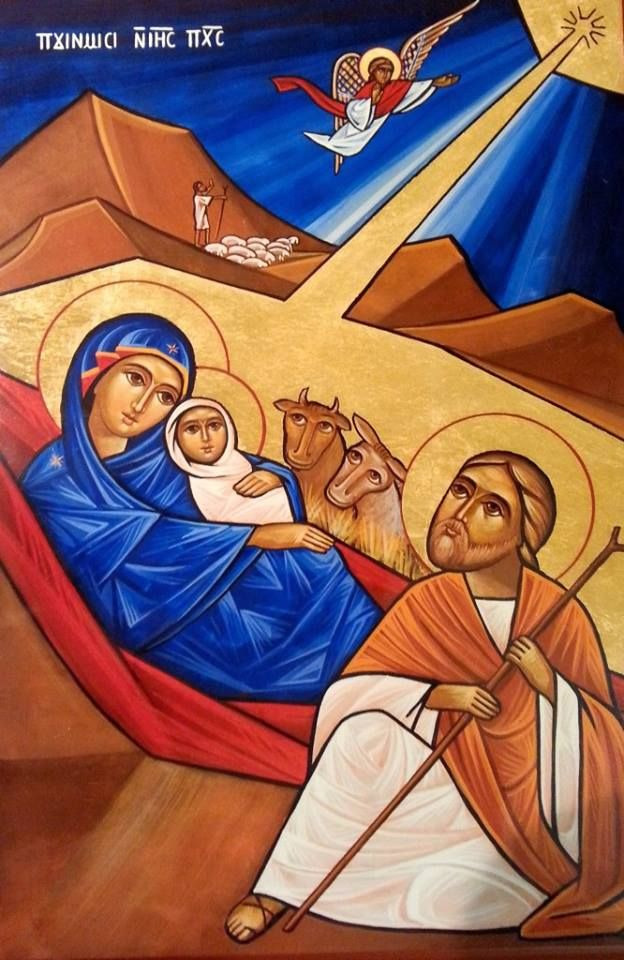Don't wanna be here? Send us removal request.
Text
HAPPY NATIVITY TO ALL FRIENDS, FOLLOWERS & READERS OF THIS BLOG!
HAPPY NATIVITY TO ALL FRIENDS, FOLLOWERS & READERS OF THIS BLOG!
Happy Nativity, according to the Coptic calendar that follows the Julian calendar, and hence the Nativity for the Copts, and many other Eastern and Oriental Christians, falls on the 7th January and not the 25th of December. Coptic Nativity is a two day celebration: the first day of Nativity is the 6th of January while the second day is the 7th of January. Prayers for Coptic Nativity are…

View On WordPress
2 notes
·
View notes
Text
PROFESSOR PHIL BOOTH AND HIS WRITINGS ON THE CHRONICLE OF JOHN OF NIKIU
PROFESSOR PHIL BOOTH AND HIS WRITINGS ON THE CHRONICLE OF JOHN OF NIKIU
Professor Phil Booth is A. G. Leventis Associate Professor in Eastern Christianity, St Peter’s College, Faculty of Theology and Religion, University of Oxford. He is interested in ecclesiastical history, in particularly the history of eastern Christianity in the eastern Roman empire. This has naturally made him come to face with the Copts and their history in that period. He has written…

View On WordPress
1 note
·
View note
Text
A NEW PROJECT DEDICATED TO THE CRITICAL EDITION OF THE CHRONICLE OF JOHN OF NIKIU
A NEW PROJECT DEDICATED TO THE CRITICAL EDITION OF THE CHRONICLE OF JOHN OF NIKIU
On 29 July 2019, Daria Elagina, a research fellow at Hiob Ludolf Centre for Ethiopian Studies, Universität Hamburg, defended with success her PhD dissertation in Ethiopian Studies: The Textual Tradition of the Chronicle of John of Nikiu: Towards the Critical Edition of the Ethiopian Version.[i] And now Elagina seems to be delivering on her intention. Recently she has divulged the excellent news…

View On WordPress
#Chronicle of John of Nikiu#Critical edition of the Chronicle of John of Nikiu#Daria Elagina#Prof. Phil Booth
1 note
·
View note
Text
KIND REQUEST FROM ON COPTIC NATIONALISM JOURNAL TO ITS READERS
The Journal of On Coptic Nationalism would like to kindly ask readers, if they approve of what we write, to like it and help in spreading the word by sharing. With many thanks and kind regards. Dioscorus Boles
View On WordPress
0 notes
Text
COPTIC RELATIONS WITH ROME 1: PURCHAS’ ACCOUNT
COPTIC RELATIONS WITH ROME 1: PURCHAS’ ACCOUNT
Samuel Purchas (c.1577 – 1626) was an English clergyman who was geographic editor and compiler of reports by travellers to foreign countries.[i] In 1625, he published the encyclopaedic Hakluytus posthumus, or, Purchas his Pilgrimes in four volumes.[ii] In 1905, J. MacLehose and sons reprinted the work in several volumes in Glasgow. Purchas speaks aboutthe Copts, whom he calls “Cophti”, at…

View On WordPress
#Church Reunion#Coptic Relations With Rome#Reunification of Christendom#Reunion between the Church of Alexandria and the Church of Rome#The Coptic Church and Catholic Church
0 notes
Text
EVEN THE LORD’S PRAYER IS MESSED UP WHEN THE COPTIC PARTICLE “Ϫⲉ” IS MISUNDERSTOOD!
EVEN THE LORD’S PRAYER IS MESSED UP WHEN THE COPTIC PARTICLE “Ϫⲉ” IS MISUNDERSTOOD!
It’s a tell-tale of the current sorry state of Coptic is the way Copts recite the Lord’s Prayer in churches and outside them. The Lord’s Prayer is wrongly called in Coptic circles ‘je pen iowt” (ϫⲉ ⲡⲉⲛ ⲓⲱⲧ). The presence of je (ϫⲉ) here is curious. The way the Copts say the Lord’s Prayer is as follows: Even when they teach their children, they use the ϫⲉ to open the prayer, as the following…

View On WordPress
1 note
·
View note
Text
PAXAMATIA – The STABLE FOOD ITEM AND MAIN CALORIE PROVIDER OF THE FATHERS OF THE DESERTS
PAXAMATIA – The STABLE FOOD ITEM AND MAIN CALORIE PROVIDER OF THE FATHERS OF THE DESERTS
The staple food of the Fathers of the Desert, and their main energy provision, as revealed in the Apophthegmata Patrum (Sayings of the Desert Fathers) was the paxamatia as the word is given in the Greek version. In the original Coptic version, it is simply called ‘oik’, which stands for bread in Coptic. What is this paxamatia? And how was it eaten? Benjamin Hansen explains: Paxamatia, a small…
View On WordPress
0 notes
Text
NO, WINE IS NOT HARAM, AND IT IS DANGEOUS TO MAKE IT SO
NO, WINE IS NOT HARAM, AND IT IS DANGEOUS TO MAKE IT SO
In modern times, we have been bombarded by strict ecclesiastical rhetoric that wine (an alcoholic drink made from fermented grape juice) is ‘haram’. Haram is of course not a Christian expression but Islamic, and finds its root in the Quran and the Traditions of Muhammad, meaning ‘forbidden’; that is, it is a sinful act. It donates the meaning that something is absolutely forbidden and is not a…

View On WordPress
1 note
·
View note
Text
WHEN POPE SHENOUTI I TOOK THE CRUSIER IN HIS HAND AND FACED THE MARAUDING ARABS An important writer of the History of the Coptic Patriarchs (HCP) is a monk by the name of Yoaannis (John) II. He was the personal clerk of Patriarch Shenouti (Sanutius or Shenouda) I (858 – ?880). He wrote the fourth part of the HCP that extended from Patriarch Mina (766 – 774) to Shenouda I, nearly one hundred…

View On WordPress
0 notes
Text
AN EXCELLENT NEW EDITION OF COPTIC-ARABIC NEW TESTAMENT PUBLISHED IN EGYPT BY THE BIBLE SOCIETY OF EGYPT
AN EXCELLENT NEW EDITION OF COPTIC-ARABIC NEW TESTAMENT PUBLISHED IN EGYPT BY THE BIBLE SOCIETY OF EGYPT
A regular correspondent (Kyrillos) has alerted me to a new publication by the Bible Society of Egypt of the New Testament in two columns: Coptic and Arabic. It is a hard cover edition, 765 pages long (with a weight of 1.7kg) and of 28.5 x 20cm page size. I do not have a copy of this bible yet but my correspondence reassures me that he has found that it has “zero jinkim errors, zero spelling…

View On WordPress
0 notes
Text
SHRINK YOUR STOMACH LITTLE BY LITTLE – THROUGH FASTING
SHRINK YOUR STOMACH LITTLE BY LITTLE – THROUGH FASTING
Gluttony by David Seidman Train yourself to shrink your stomach little by little through fasting. The same as a stretched water skin shrinks, so it is with a stomach that takes a lot of food. If on the contrary, it takes in little, it shrinks and needs less and less. ~ Eulogius, 4th century Desert Father The Fathers of the Desert knew how to control appetite/gluttony/satiety, stomach capacity…

View On WordPress
0 notes
Text
BOTH THE COPTIC READER AND THE COPTIC BIBLE APPs NEED TO PAY MORE ATTENTION TO THE IMPORTANCE OF THE JINKIM IN THEIR TEXTS
BOTH THE COPTIC READER AND THE COPTIC BIBLE APPs NEED TO PAY MORE ATTENTION TO THE IMPORTANCE OF THE JINKIM IN THEIR TEXTS
The two digital apps – the Coptic Reader which was produced several years ago by the Coptic Orthodox Diocese of the Southern United States to help with the liturgical services of the Church, and the Coptic Bible which was produced in 2021 by Saint Shenouda the Archimandrite Society to assist in the study of Coptic in general – have been great developments in the field of Coptology. I have written…
View On WordPress
0 notes
Text
INTERNATIONAL CONFERENCE ON THE COPTIC EDUCATIONAL SYSTEMS AND INSTITUTIONS (11TH CENTURY-PRESENT) IN CAIRO 17-19 FEBRUARY 2022
INTERNATIONAL CONFERENCE ON THE COPTIC EDUCATIONAL SYSTEMS AND INSTITUTIONS (11TH CENTURY-PRESENT) IN CAIRO 17-19 FEBRUARY 2022
In a collaborative effort, the St. Mark Foundation for Coptic Heritage and the Institut français d’archéologie orientale (or IFAO) are holding on 17-19 February 2022 an international conference on the Coptic Educational Systems and Institutions (11th century-present) in Cairo. It may be live videoed. Readers are advised to keep an eye on the event which may be videoed by following the IFAO.…

View On WordPress
0 notes
Text
SHAME ON THE MONASTERY OF SAINT MACARIUS THE GREAT FOR ITS NEGLECT OF THE NATIONAL LANGUAGE OF THE COPTS
SHAME ON THE MONASTERY OF SAINT MACARIUS THE GREAT FOR ITS NEGLECT OF THE NATIONAL LANGUAGE OF THE COPTS
The Monastery of Saint Macarius the Great (Dayr Aba Maqār, دير الأنبا مقار) is one of the greatest Coptic monasteries that has had a great impact on Coptic Christianity and history. It lies in Wadi al-Natrun some 92 km north-west of Cairo, in the Western Desert of Egypt. In Coptic, it is called Ⲡⲓⲙⲟⲛⲥⲧⲏⲣⲓⲟⲛ (ⲓⲉ ⲡⲓⲁ̀ⲃⲏⲧ) ⲛ̀ⲧⲉ ⲡⲓⲁⲅⲓⲟⲥ ⲡⲓⲛⲓϣϯ ⲁⲡⲁ Ⲙⲁⲕⲁⲣⲓⲟⲥ. This monastery would be expected to be one…

View On WordPress
0 notes
Text
WE MUST LOOK AT OURSELVES AS A NATION, A DISTINCT NATION, AND PROMOTE OUR NATIONAL INTERESTS
WE MUST LOOK AT OURSELVES AS A NATION, A DISTINCT NATION, AND PROMOTE OUR NATIONAL INTERESTS
The Copts are a nation with sufficient and strong criteria for nationhood. When I talk about nationhood here, I do not mean political nationhood that requires national determination and sovereignty. No one calls for that, though it is a right that any nation should retain, and should use in extreme cases. Our nationhood is cultural – it is based on the fact that we are culturally different from…
View On WordPress
0 notes
Text
SCHOOL OF COPTIC STUDIES OUTSIDE EGYPT
SCHOOL OF COPTIC STUDIES OUTSIDE EGYPT
In Egypt there is the Institute of Coptic Studies in Cairo, which is attached to the Coptic Patriarchate at the Abbasiyya where the Cathedral of St. Mark is based. It provides good courses in Coptic studies, but as in every thing in Egypt, particularly Coptic studies, it is not entirely free, and the scope of studies or their depth is limited. There is always the Muslim Big Brother watching over…
View On WordPress
0 notes
Text
THE HISTORY OF THE COPTIC PATRIARCHS IS IN URGENT NEED OF TRANSLATION INTO PROPER ENGLISH FROM AD 849 UNTIL MODERN TIMES
THE HISTORY OF THE COPTIC PATRIARCHS IS IN URGENT NEED OF TRANSLATION INTO PROPER ENGLISH FROM AD 849 UNTIL MODERN TIMES
The History of the Coptic Patriarchs (HCP) is a monumental, historical work of the Coptic Church that covers the lives of its patriarchs from St. Mark the Evangelist, its 1st patriarch in the first century, to Cyril V, its 112th patriarch in the late nineteenth century (1896). I find the title History of the Coptic Patriarchs more accurate and convenient to give to this work than any other title…
View On WordPress
#Coptic history#History of the Church of Alexandria#History of the Coptic Patriarchs#History of the Egyptian Church
1 note
·
View note